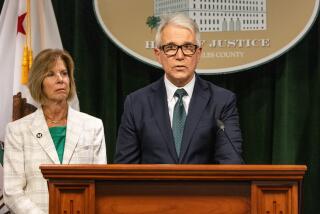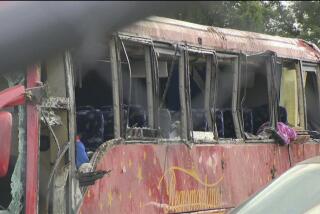Crash Victims Are Mourned in Ensenada
- Share via
ENSENADA — This seaside city mourned its dead Wednesday, an emotional day that concluded with multiple burial services in a hillside cemetery.
Beneath leaden skies and acrid smoke from the nearby city dump, hundreds of residents turned out for the interment of most of the victims of Monday’s bus crash--called the worst vehicular accident ever in this city 70 miles south of San Diego.
At least 16 people died when the bus veered off a steep road and plunged 50 yards down a precipice; more than 2 dozen others were injured, many seriously. Some estimates put the death toll as high as 19, but there was no official confirmation.
Officials vowed a thorough investigation, but authorities and officials of the bus company were quick to point out that some accidents are unavoidable. Authorities said the vehicle’s brakes apparently failed.
“It was an unfortunate event, but accidents do happen,” said Elias Padilla Gonzalez, chief of the state transportation department in Ensenada.
Yes, Padilla agreed, the vehicle probably hadn’t been inspected for more than a year, in apparent violation of a law that requires a state inspection every two months. But he noted that he had only been in office for two weeks and had already begun a new round of inspections for the entire urban transport system. Besides, he added, the accident might have occurred even if there had been adequate inspections.
“I don’t think the bus company or authorities are responsible for this unfortunate incident,” Padilla said.
Such sentiment was small consolation to survivors and to relatives and friends of the dead. They expressed outrage and anger, most of it directed at state officials and the Rojo y Blanco (Red and White) transport cooperative, which owned the bus. The mourners, most of them poor like the victims, gathered at the funeral home and by the graveside, venting their frustration at what they view as yet another example of the compromises made with their safety and well-being. Many had ashes on their foreheads in observance of Ash Wednesday, the first day of Lent.
“These buses are in the worst condition, and we have to ride them; we have no choice,” said a tearful Ofelia Avalos de Trejo, whose 19-year-old son, Javier, was among the victims.
Ten months earlier, she had lost her youngest child, a 12-year-old girl, to kidney disease. The family, like so many others in northern Mexico, were migrants from the Mexican interior--in this case, the southern state of Guerrero--who had come to the north seeking a better life.
“Javier was a good boy,” the mother said as journalists and onlookers gathered on the street outside the funeral home. “He never drank or smoked. He was going to school. He wanted to better himself.”
Inside the funeral home, the body of her son was on view in his coffin; a few long-stemmed roses rested on his chest. He wore a denim jacket.
The corpses were laid out in four rooms. In the largest, eight victims were lined up side by side. The faces showed obvious signs of trauma. Before the
caskets were closed, a priest said a prayer.
Condemnation of the local transportation service was widespread here. In every Mexican city, the vintage buses, often former school buses from the United States, provide a lifeline to the outlying communities where much of the population lives. But residents complained of the buses’ dilapidated condition, their constant tardiness and unreliability and the sometimes-reckless driving habits of those behind the wheels.
“Some of these vehicles aren’t fit for animals,” said Crecensio Hernandez Ramirez, a 29-year-old father of four who came to the wake to pay tribute to a co-worker who died in the crash. “My children could have been on that bus! What would I have done then?”
At the headquarters of the Rojo y Blanco bus company near downtown, officials said they regretted the loss of life. But, they insisted, the bus--a 1968 Chevrolet--was in good shape: It had made three other runs Monday morning before the accident, which occurred at 11:30 a.m. The driver, Martin Rosales Mexica, although only 21 and an employee for less than a year, was a qualified driver, they said. (He died in the crash.) Officials acknowledged that the company’s insurance policy had lapsed a few days earlier, but they described that as only a technicality.
“We wouldn’t allow a vehicle with mechanical problems to go into service,” said Adrian Ramirez Martinez, president of the 120-vehicle company, which transports about 15,000 city residents each day.
At any rate, the company’s civil liability appears to be limited under Mexican law. There were no hordes of lawyers contacting family members, as there might have been if the accident had occurred in the United States.
A state prosecutor, Fernando Cota Pedrin, said the firm must pick up the tab for funeral and medical expenses, which are likely to total less than $20,000. The company, Cota said, is also required to provide remuneration to the families of the dead. One estimate put the amount at $2,000 per family, although it was unclear whether all will be entitled to that amount.
As for potential criminal charges, Cota said it was unclear whether there was any criminal liability. An investigation is continuing, he said.
Late in the day, mourners made their way to the small cemetery on the outskirts of the town. By the time the hearses arrived, hundreds had gathered around the freshly dug graves. A man carried white wooden crosses bearing the names of the dead. Inmates observed from atop the walls of the nearby jail.
Before the sun set, mourners were placing earth on the final resting places of Javier Trejo and the others who perished on the last trip of Rojo y Blanco bus No. 137.
More to Read
Sign up for Essential California
The most important California stories and recommendations in your inbox every morning.
You may occasionally receive promotional content from the Los Angeles Times.









